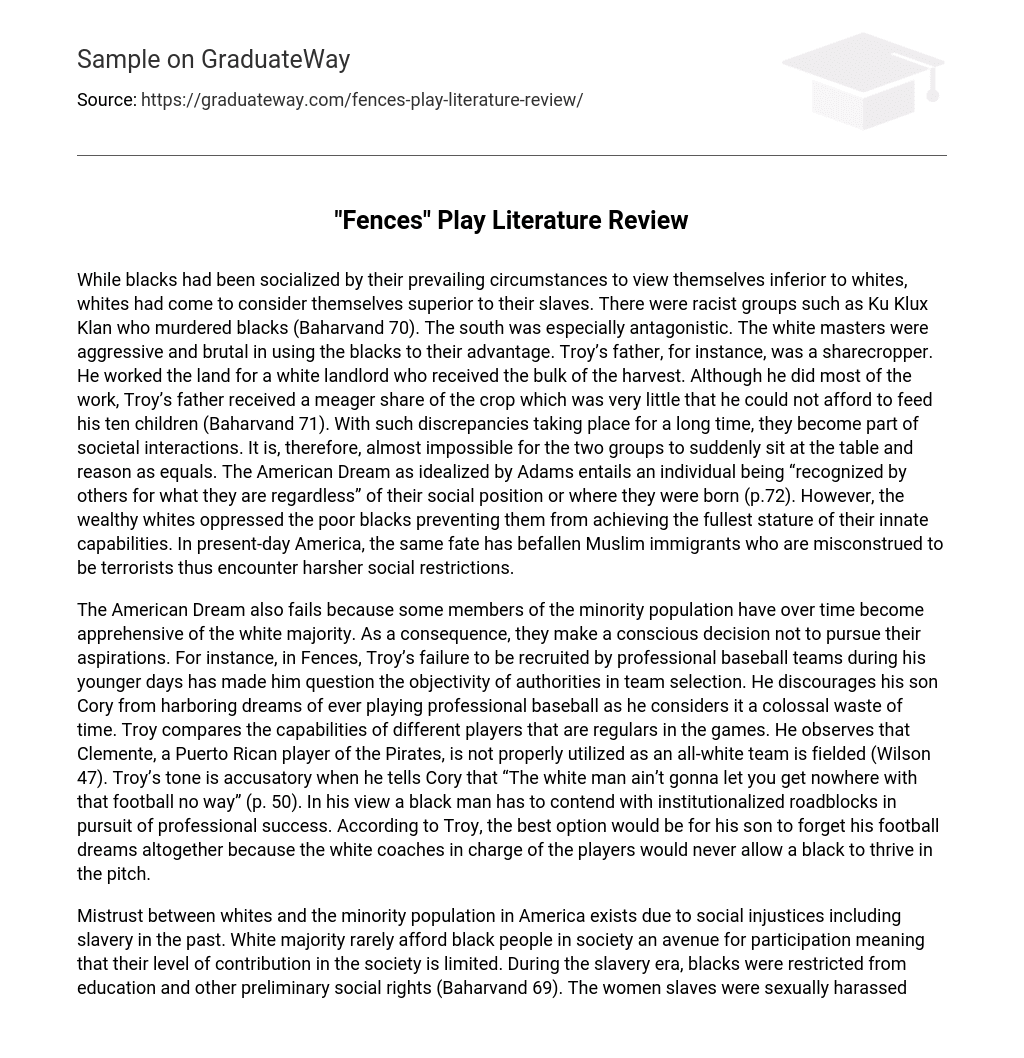While blacks had been socialized by their prevailing circumstances to view themselves inferior to whites, whites had come to consider themselves superior to their slaves. There were racist groups such as Ku Klux Klan who murdered blacks (Baharvand 70). The south was especially antagonistic. The white masters were aggressive and brutal in using the blacks to their advantage. Troy’s father, for instance, was a sharecropper. He worked the land for a white landlord who received the bulk of the harvest. Although he did most of the work, Troy’s father received a meager share of the crop which was very little that he could not afford to feed his ten children (Baharvand 71). With such discrepancies taking place for a long time, they become part of societal interactions. It is, therefore, almost impossible for the two groups to suddenly sit at the table and reason as equals. The American Dream as idealized by Adams entails an individual being “recognized by others for what they are regardless” of their social position or where they were born (p.72). However, the wealthy whites oppressed the poor blacks preventing them from achieving the fullest stature of their innate capabilities. In present-day America, the same fate has befallen Muslim immigrants who are misconstrued to be terrorists thus encounter harsher social restrictions.
The American Dream also fails because some members of the minority population have over time become apprehensive of the white majority. As a consequence, they make a conscious decision not to pursue their aspirations. For instance, in Fences, Troy’s failure to be recruited by professional baseball teams during his younger days has made him question the objectivity of authorities in team selection. He discourages his son Cory from harboring dreams of ever playing professional baseball as he considers it a colossal waste of time. Troy compares the capabilities of different players that are regulars in the games. He observes that Clemente, a Puerto Rican player of the Pirates, is not properly utilized as an all-white team is fielded (Wilson 47). Troy’s tone is accusatory when he tells Cory that “The white man ain’t gonna let you get nowhere with that football no way” (p. 50). In his view a black man has to contend with institutionalized roadblocks in pursuit of professional success. According to Troy, the best option would be for his son to forget his football dreams altogether because the white coaches in charge of the players would never allow a black to thrive in the pitch.
Mistrust between whites and the minority population in America exists due to social injustices including slavery in the past. White majority rarely afford black people in society an avenue for participation meaning that their level of contribution in the society is limited. During the slavery era, blacks were restricted from education and other preliminary social rights (Baharvand 69). The women slaves were sexually harassed by their white bosses, and families were often disintegrated as slaveholders sold them for money. In present-day America, most industries require intense labor that is provided by non-skilled immigrants. This population group has normalized the meager wages earned. More minority populations continue to immigrate to America to provide similar services. There is a negligible population of whites who offer such services. Therefore, there is an undocumented yet widely accepted notion that immigrant populations can provide cheap and readily available labor.
In conclusion, the American dream is an ideal untenable to most immigrants. From Fences, there are three main reasons that hinder the attainment of this ideal. Firstly, there some of the policies formulated by institutions discriminate against the minority immigrant population and make it harder for them to succeed as compared to the white majority. Secondly, socialization of minority populations makes some settle for a substandard life because that is all they have been accustomed to, and accept it as their ‘normal’. Thirdly some of the policies in institutions make it harder for minority populations to be accepted and to succeed compared to the white majority. Baharvand examines how the ‘American dream’ fails in Fences. The author also considers how opportunities are still no better for “others” in present-day America. For the non-white population, the “American dream” remains elusive.





